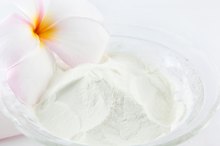How Are Human Growth Hormones Manufactured?
Growth hormone is a protein produced by the pituitary gland, which is a pea-sized gland located below the brain. Growth hormone is one of the hormones critical for normal growth in children and adolescents, and it is also involved in regulating metabolism. In adults, growth hormone deficiency is extremely rare. Growth hormone deficiency in children and adults is treated by injections of recombinant human growth hormone, or rHGH 1.
History
Until the early 1980s, human growth hormone was obtained from the brains of human cadavers 1. The National Institutes of Health, or NIH, developed a program in 1960 to procure growth hormone from human cadavers 1. The process of obtaining growth hormone from cadavers was expensive and time-consuming and in the late 1970s was discovered to be associated with a small risk of contracting Creutzfeldt-Jakob disease. According to the United States National Endocrine and Metabolic Diseases Information Service, in 1977, 28 cases of Creutzfeldt-Jakob disease were documented among 7,700 people that were treated with human growth hormone in the United States 12. Improvement of the isolation and purification techniques of HGH from cadavers did eliminate the risk of developing Creutzfeldt-Jakob disease.
Recombinant Protein
Does Meat Contain Estrogen?
Learn More
Growth hormone is a protein of 191 amino acids. Each amino acid is encoded by a sequence of DNA. Recombinant DNA is DNA made artificially in the laboratory. Sequences of DNA are put together until the entire protein is encoded. Then, the recombinant DNA is inserted into cells that mass produce the protein.
- Growth hormone is a protein of 191 amino acids.
- Sequences of DNA are put together until the entire protein is encoded.
Inclusion Body Technology
The first method of manufacturing rHGH was called inclusion body technology. In this process E. coli bacteria mass produce rHGH, which accumulates in small bodies inside the bacteria. These small bodies are isolated and the highly enriched rHGH is separated and purified. The rHGH produced by this technology differs by one extra amino acid at the end of the protein. Although this rHGH was an improvement to cadaver derived growth hormone, the extra amino acid caused an allergic reaction in some people.
- The first method of manufacturing rHGH was called inclusion body technology.
- In this process E. coli bacteria mass produce rHGH, which accumulates in small bodies inside the bacteria.
Protein Secretion Technology
Negative Side Effects While Using HGH
Learn More
As of 2010, a newer technology is used to manufacture most currently available rHGHs on the market. It is referred to as protein secretion technology, and its major advantage is that rHGH is secreted from E. coli and does not accumulate in inclusion bodies. This process allows for easier purification of rHGH and the production of rHGH that is identical to human growth hormone 1.
Mouse-Cell Technology
Producing rHGH using mouse-cell technology involves insertion of the DNA that encodes for human growth hormone into the DNA in mouse cells 1. The protein is produced in mouse cells instead of E. coli bacteria in the laboratory. Although more costly initially, this process produces rHGH that requires less manipulation and purification. This technology also produces rHGH that is identical to human growth hormone 1.
Related Articles
References
- Melmat, Shlomo. "Physiology of Growth Hormone." UpToDate.com. 2015.
- Rogol, Alan D. "Treatment of Growth Hormone Deficiency in Children." UpToDate.com. June, 2015.
- Snyder, Peter J. "Growth Hormone Deficiency in Adults." UpToDate.com. 2015.
- Snyder, Peter J. "Use of Androgens and Other Drugs by Athletes." UpToDate.com. 2016.
- Bates, A.S., et al. "The Effect of Hypopituitarism on Life Expectancy." Journal of Clinical Endocrinology and Metabolism 81 (1996):1169-72.
- Baum, H.B., et al. "Effects of Physiologic Growth Hormone Therapy on Bone Density and Body Composition in Patients With Adult-Onset Growth Hormone Deficiency: A Randomized, Placebo-Controlled Trial." Annals of Internal Medicine 125 (1996):883-90.
- Bengtsson, B.A., et al. "Treatment of Adults with Growth Hormone (GH) Deficiency With Recombinant Human GH." Journal of Clinical Endocrinology and Metabolism 76 (1993):309-17.
- Biller, B.M., et al. "Withdrawal of Long-Term Physiological Growth Hormone (GH) Administration: Differential Effects on Bone Density and Body Composition in Men With Adult-Onset GH Deficiency." Journal of Clinical Endocrinology and Metabolism 85 (2000):970-6.
- Carroll, P.V., et al. "Growth Hormone Deficiency in Adulthood and the Effects of Growth Hormone Replacement: A Review." Journal of Clinical Endocrinology and Metabolism 83 (1998):382-95.
- Koranyi, J., et al. "Baseline Characteristics and the Effects of Five Years of GH Replacement Therapy in Adults With GH Deficiency of Childhood or Adulthood Onset: A Comparative, Prospective Study." Journal of Clinical Endocrinology and Metabolism 86 (2001): 4693-9.
- Sassolas, G., et al. "GH Deficiency in Adults: An Epidemiological Approach." European Journal of Endocrinology 141 (1999):595-600.
- Sesmilo, G., et al. "Effects of Growth Hormone Administration on Inflammatory and Other Cardiovascular Risk Markers in Men With Growth Hormone Deficiency: A Randomized, Controlled Clinical Trial." Annals of Internal Medicine 133(2000):111-22.
- Stochholm, K., et al. "Incidence of GH Deficiency - A Nationwide Study." European Journal of Endocrinology 155 (2006):61-71.
Writer Bio
Melissa Lingohr-Smith is a freelance medical writer with over 10 years experience in research science, teaching and scientific writing. She has published scholarly articles, received grant funding in diabetes research and is experienced in biochemistry, molecular biology, endocrinology, physiology, toxicology, pharmacology, clinical studies and FDA approvals. She has a Ph.D. in pharmacology/toxicology.









